Physical Address
304 North Cardinal St.
Dorchester Center, MA 02124
Physical Address
304 North Cardinal St.
Dorchester Center, MA 02124
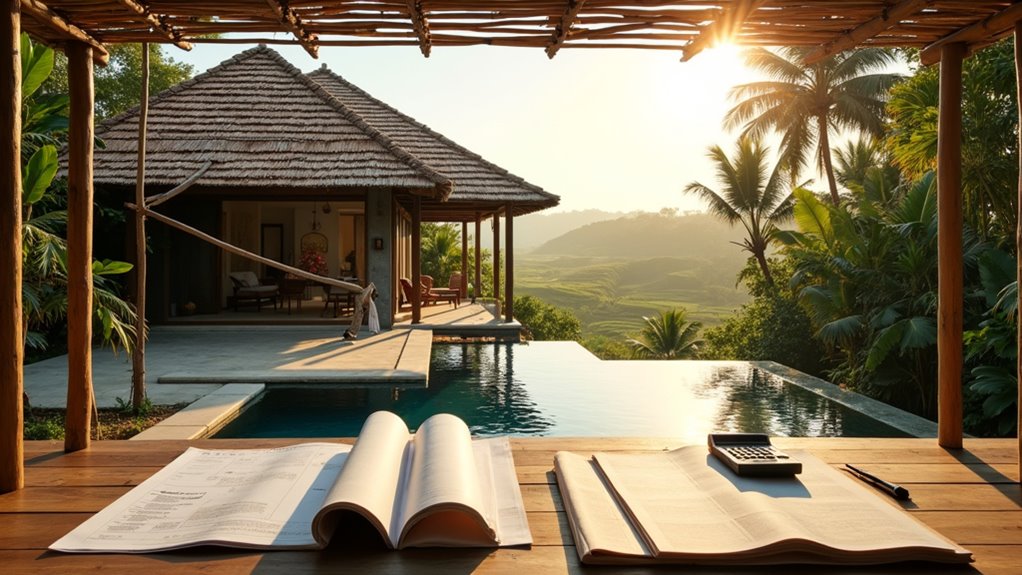
Key Bali villa construction costs revealed, from budget-friendly builds to luxurious estates that could either fulfill dreams or drain savings.
Building your dream villa in Bali combines tropical fantasy with practical investment concerns. You’ll face important financial decisions that can make or break your project’s success. The price tag varies dramatically—from modest $140,000 builds to luxury estates exceeding $280,000—depending on countless variables you might not have considered. Understanding these cost factors isn’t just helpful; it’s essential for preventing budget disasters and ensuring your Indonesian paradise doesn’t become a financial nightmare.
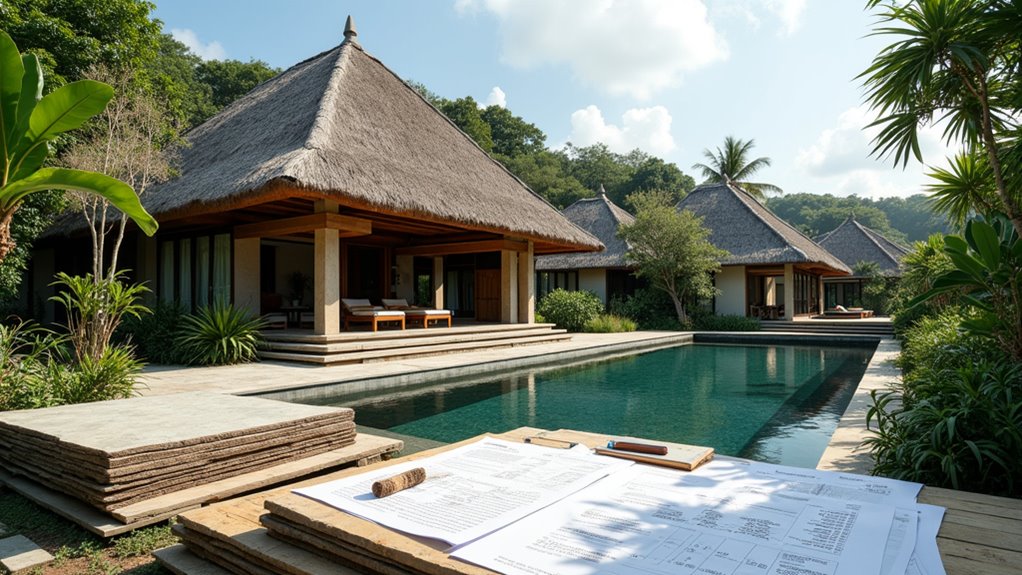
When planning your Bali villa project, understanding the per-square-meter costs will help establish a realistic budget from the start.
In today’s market, you’ll find significant variation in construction expenses depending on quality and location.
Mid-range villas typically cost between IDR 10-15 million per square meter (approximately USD 700-1,050), while luxury properties start at IDR 20 million (USD 1,400+) and can exceed IDR 25 million for beachfront locations. Building costs have risen from IDR 9M to IDR 12M per square meter over four years since 2019.
For perspective, a 200-square-meter mid-range villa would total around IDR 2 billion (USD 140,000), while the same-sized luxury villa might start at IDR 4 billion (USD 280,000+).
These prices have increased substantially, with some areas seeing a 33% rise between 2020-2024, and experts project additional 5-10% annual growth through 2025. Many investors choose to build custom villas rather than purchasing existing properties to better control costs and design elements.
Building your dream villa in Bali requires understanding different construction cost categories to properly align your expectations with your budget.
At the basic level, you’ll invest around IDR 6 million per m² for simple designs with lower-skilled labor and fewer amenities.
Well-built villas cost between IDR 7-8 million per m² with better finishes and standard features like small pools.
Mid-range options exceed IDR 8 million per m² with higher-quality materials and larger amenities.
For luxury builds featuring premium materials like wood and marble, expect costs starting at IDR 22.9 million per m².
Multi-story and complex projects range from IDR 10.9-12.4 million per m², requiring additional structural considerations and permits.
Adding a swimming pool will increase your total investment by approximately IDR 2 million per square meter of pool area.
Each category offers distinct advantages depending on your vision and financial framework.
Building in the Island of Gods has become increasingly popular due to Bali’s paradise-like setting and unique cultural offerings.
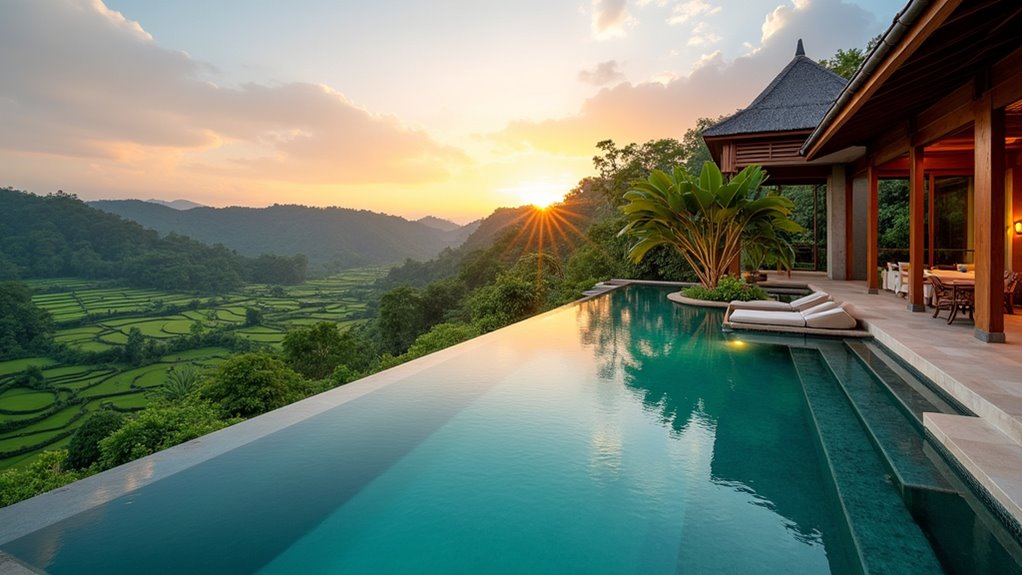
Two major factors that considerably influence your Bali villa budget are swimming pools and landscaping. Pool construction costs average IDR 3.5 million per square meter, with larger pools (50+ sqm) costing more than smaller designs (20-30 sqm). Your choice of materials—from budget ceramic tiles to premium natural stone—significantly impacts the final price. Consulting with Bali-Contractor experts can provide more accurate cost estimates tailored to your specific project requirements.
When planning your pool and landscaping budget, consider:
Many villa owners incorporate Balinese massage areas into their landscaping design, creating dedicated wellness spaces that enhance both the property value and guest experience.
Material selection stands as the single most influential factor in your Bali villa construction budget. Basic constructions start around IDR 5 million per square meter, while luxury options with premium materials like marble can reach IDR 10 million or more per square meter.
When selecting materials, consider both immediate costs and long-term value. Durable options might cost more initially but reduce maintenance expenses over time. Construction costs in Bali typically range from IDR 7.1 million to 7.5 million per square meter, equivalent to approximately USD $475 per square meter for standard builds.
Materials must also withstand Bali’s humid climate to prevent degradation. While Bali has a reputation for being an affordable destination for travelers, construction costs can vary significantly from tourism expenses.
You’ll face critical trade-offs: luxury wood and marble can elevate costs to IDR 22.9 million per square meter—more than quadruple basic rates.
Consider phased construction to manage cash flow, and explore local material sourcing to reduce expenses.
Always reserve 10-15% as contingency for unexpected costs that inevitably arise during construction.
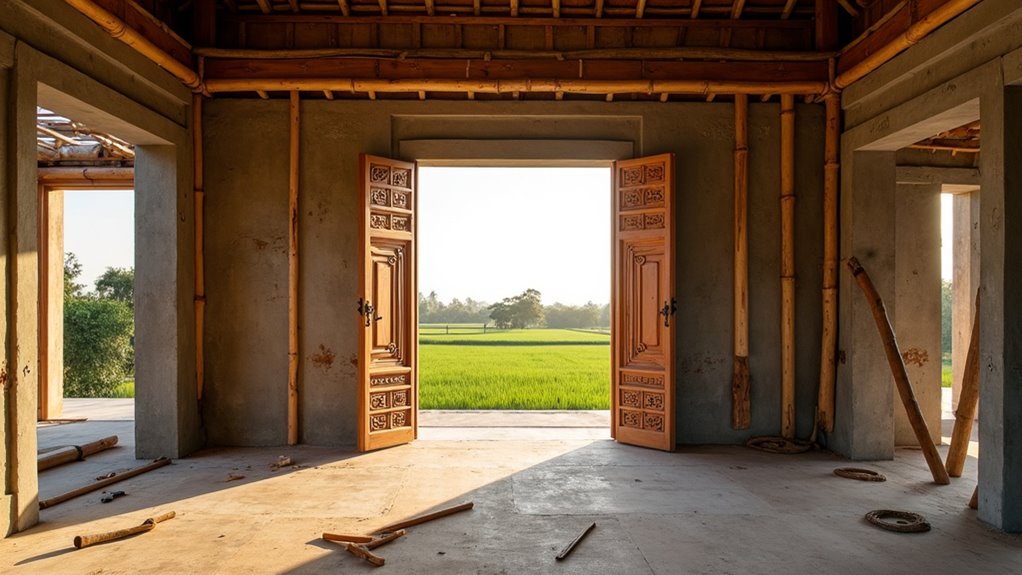
While luxury materials markedly impact your budget, the architectural complexity of your Bali villa design plays an equally crucial role in determining final costs. The unique fusion of traditional Balinese elements with modern luxury features creates varying price points depending on your design choices.
The marriage of Balinese tradition with contemporary luxury shapes your villa’s cost structure beyond just material selection.
Key considerations affecting your budget include:
Beyond architectural considerations, your villa’s location in Bali considerably impacts your overall investment. Seminyak and Canggu command premium prices ($300,000-$1,000,000) due to their popularity with travelers and investors seeking rental returns.
If you’re working with a tighter budget, consider Ubud ($200,000-$600,000) for nature-focused properties, or Sanur/Nusa Dua ($150,000-$400,000) for more affordable beachside options. Sanur offers must-visit destination appeal with its relaxed atmosphere while maintaining competitive property prices. Tabanan offers rural properties between $100,000-$300,000. Properties with ocean views typically command significantly higher prices regardless of the region.
Amed presents particularly attractive opportunities with markedly lower land acquisition costs compared to western regions.
Remember that accessibility, available amenities, and local regulations will vary across regions. Areas with strong tourism demand and developing infrastructure typically yield higher rental income potential, balancing your initial higher investment with better long-term returns.
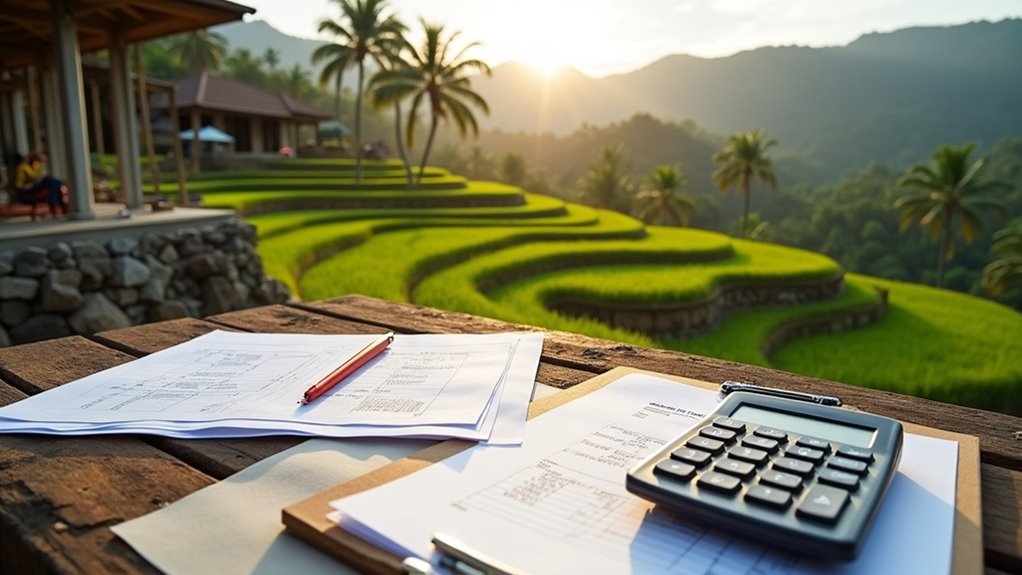
When planning your Bali villa project, you’ll need to account for numerous hidden costs that can substantially impact your final budget. Beyond construction expenses, regulatory fees and compliance costs can add significant sums to your investment.
Remember that permit approvals typically take 2-6 months but can stretch longer with incomplete documentation. Currency fluctuations, material shortages, and weather conditions may also create unexpected expenses. Green zone projects require specialized environmental assessments that can add between $630-$6,300 to your overall costs. If you’re planning to stay during construction phases, factor in costs for appropriate visa options depending on your expected length of stay in Bali.
Allocate at least 15-20% of your budget as contingency for these unforeseen costs.
Three primary paths exist for acquiring land in Bali, each with distinct financial implications for your villa project. Leasehold agreements offer flexibility with annual costs ranging from $800-$20,000 per are (100m²), typically lasting 25-30 years—ideal if you’re seeking lower upfront investment.
Leasehold agreements provide flexibility with lower initial costs—perfect for entrepreneurs prioritizing capital efficiency in Bali’s competitive property market.
For longer-term control, Hak Pakai (Right to Use) permits foreigners with residency permits to secure land for up to 25 years, renewable for another 20-25 years, though it can’t be inherited.
Location dramatically affects pricing: expect $20,000-$500,000+ in Seminyak/Canggu, while emerging areas like Tabanan offer better value. Understanding local zoning regulations is crucial as they determine what type of development is permitted on your land.
For ownership structures, consider a PT PMA (foreign-owned company) for maximum security despite higher setup costs, or explore joint ventures with local partners to share expenses. If you want to enjoy thrilling activities between property viewings, Jakarta offers numerous adventure options just a short flight away from Bali.
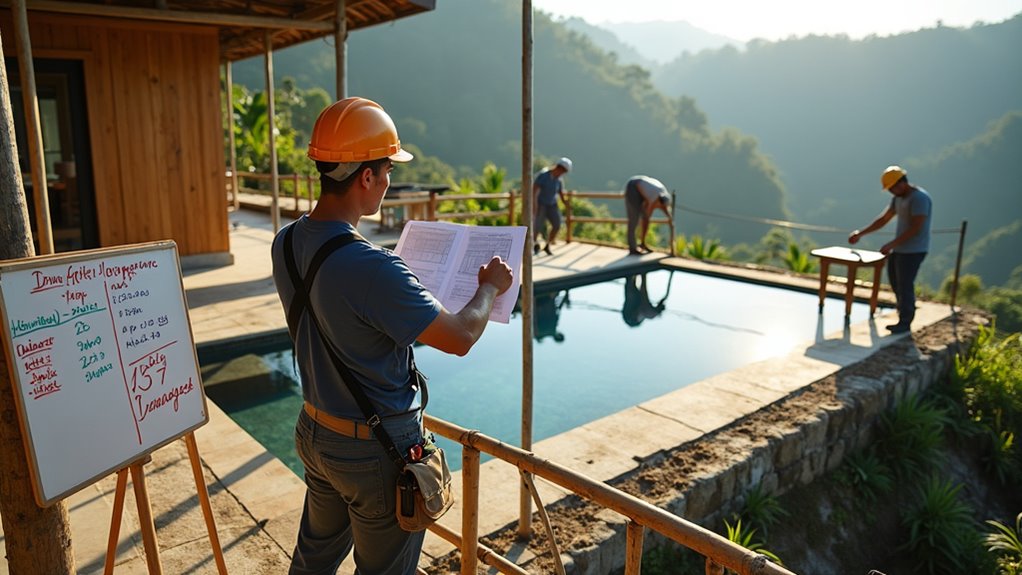
Understanding your villa project’s timeline is essential as it directly impacts your bottom line. Most Bali villas take between 6-18 months to complete, with larger projects requiring more time and resources. Effective timeline management can markedly reduce your overall expenses.
Key timeline factors affecting your costs:
Your contract should specify clear payment milestones aligned with construction phases to ensure financial protection throughout the project duration.
Remember that construction delays almost always translate to increased costs, making timeline management a fundamental budget consideration. Many contractors can incorporate Balinese design elements into your villa, reflecting the island’s rich culinary and cultural heritage.
Building your dream villa in Bali doesn’t have to drain your bank account if you implement strategic cost-saving measures throughout the construction process.
Start by using local materials like stone, bamboo, and teak while hiring Balinese workers rather than importing labor. Adopt minimalist, open-plan designs that maximize space efficiency and incorporate natural ventilation to reduce long-term energy costs. Consider phasing your construction by building gradually, starting with essential rooms first and expanding over time as your budget allows.
Consider modular construction or 3D printing to minimize waste. Installing energy-efficient systems like solar panels and rainwater harvesting can also help save money over time.
Manage your project with detailed budgeting and regular audits, while maintaining a 10-15% contingency fund for unexpected expenses.
When finishing your villa, explore thrift marketplaces for furnishings. Commission local artisans for custom pieces, and choose low-maintenance surfaces like polished concrete that will save money for years to come. For outdoor spaces, incorporate shoestring budget design elements like repurposed materials and locally sourced plants to create beautiful gardens without excessive costs.
Like a skilled fisherman steering Bali’s waters, you’ll need preparation and patience for your villa project. You’re looking at $700-1,400 per square meter, with total costs varying widely based on your choices. Remember, your dream villa isn’t just about the foundation and walls—it’s about balancing quality, design, and budget while navigating local regulations. With careful planning, you’ll create your paradise without emptying your treasure chest.